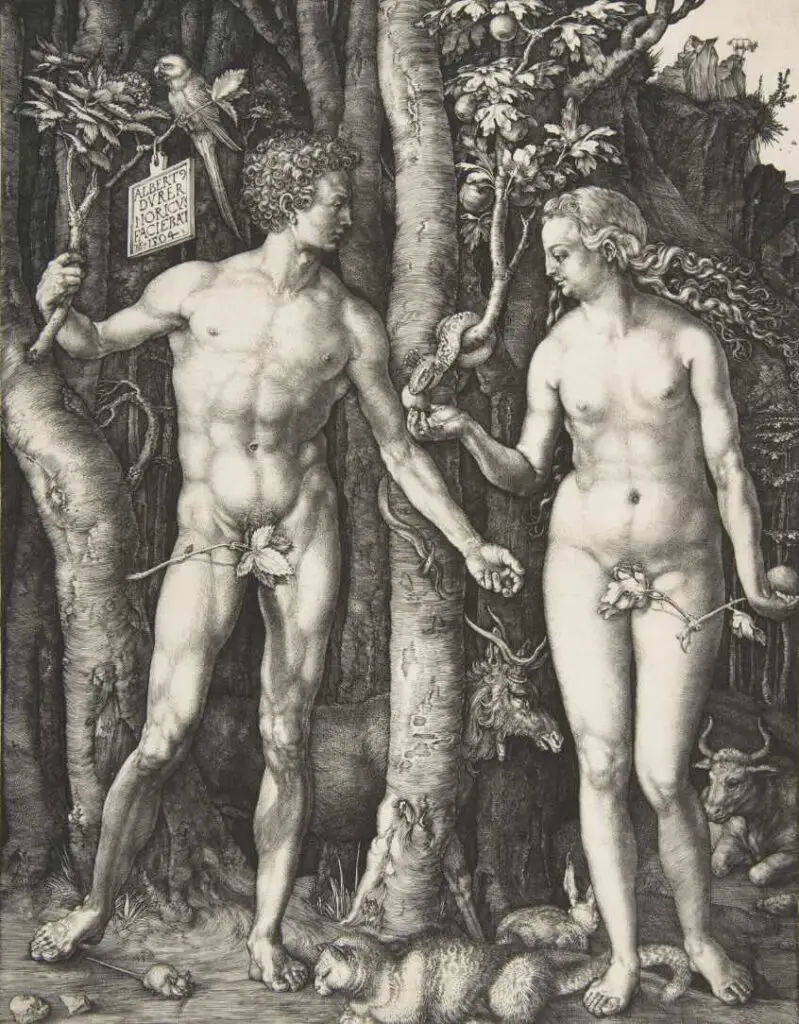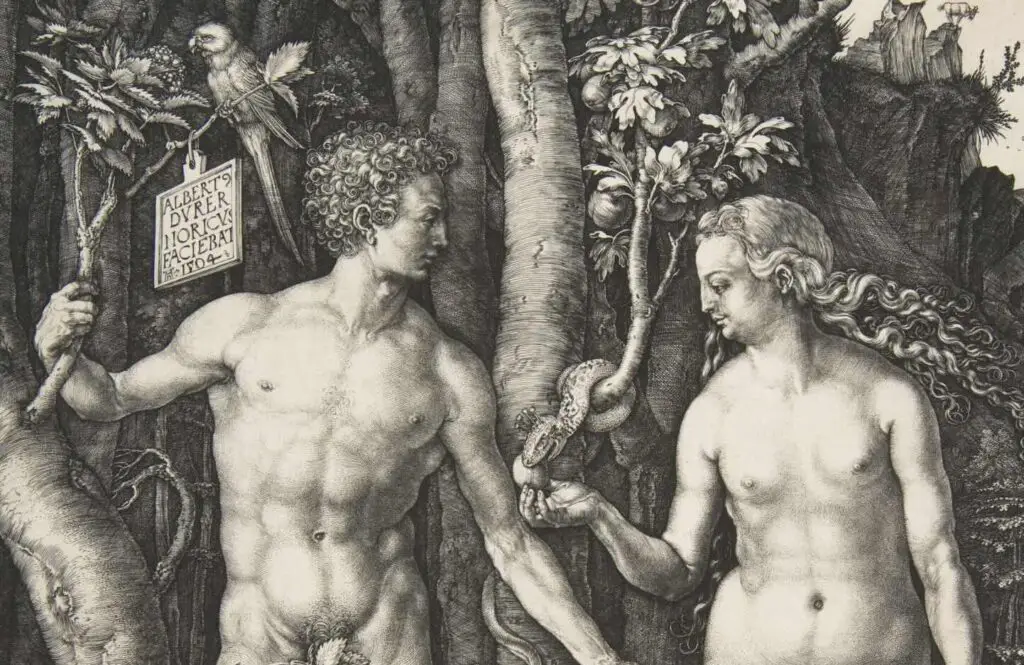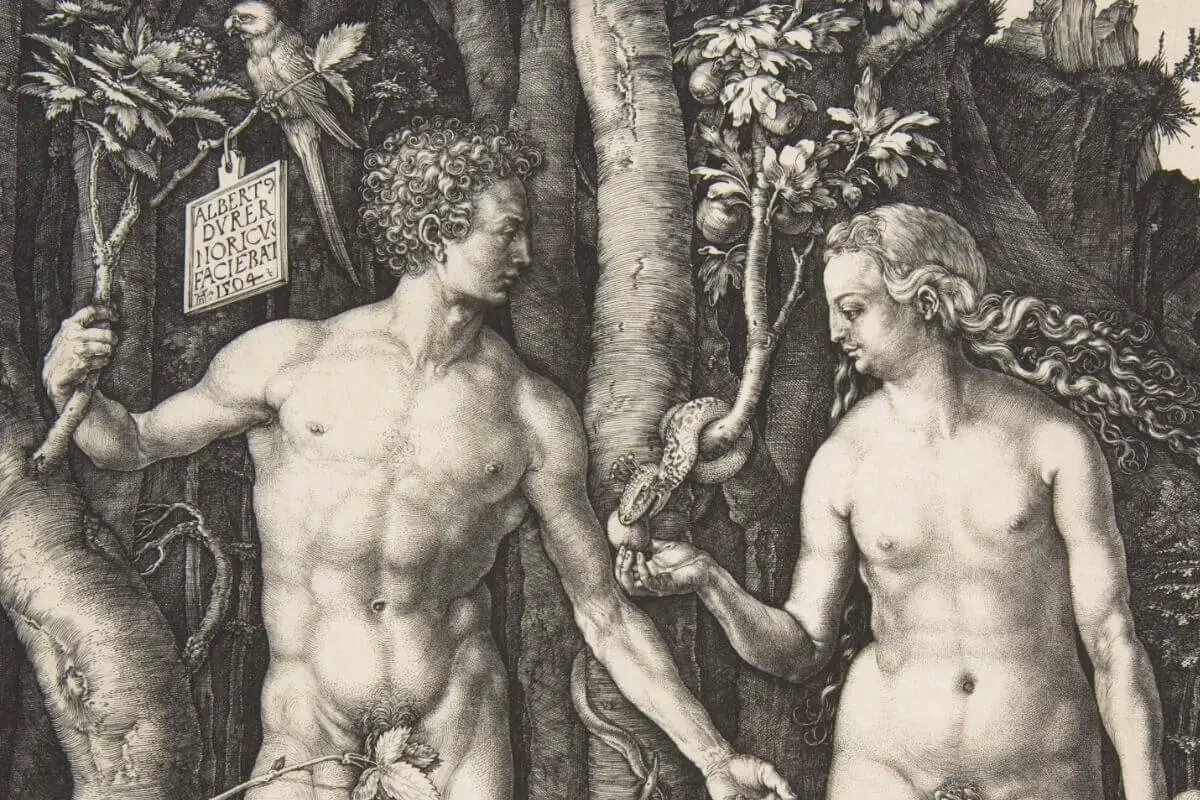Albrecht Dürer’s masterpiece, ‘Adam and Eve,’ is a doorway to understanding the richness of the Renaissance era. It presents a unique blend of artistic skill, intellectual curiosity, and a profound observation of nature and humanity.
This piece offers a glimpse into how Dürer’s work captures the essence of his time, integrating classical influences with a modern, thoughtful approach to the subjects he portrayed. Through his depiction of ‘Adam and Eve,’ the artist invites us to explore the complexities of human nature, belief, and the natural world, providing a window into the transformative period of the Renaissance.
Table of Contents
- Historical Context of Albrecht Dürer’s Work
- Symbolism and Detail in ‘Adam and Eve’
- Technical Mastery and Innovation
- Impact and Legacy
- Related Questions
Historical Context of Albrecht Dürer’s Work
Albrecht Dürer, a name synonymous with the Renaissance’s magnificent unfolding in Northern Europe, was not just an artist but a scholarly bridge between two worlds. Born in the bustling city of Nuremberg in 1471, his existence was cradled by an era rife with religious ferment, burgeoning scientific inquiry, and a resurgent interest in the classical past.
During this period, Europe was a crucible of change, the old medieval order giving way to new modes of thinking, seeing, and representing the world. It is within this crucible that Dürer’s ‘Adam and Eve’ comes to life—a testament to his exceptional skill and the intellectual currents of his time.
The artwork ‘Adam and Eve,’ created in 1504, represents not merely the biblical first humans but an intricate narrative woven with symbols, harmonies, and contrasts that speak volumes of the era’s preoccupations.
The Renaissance, a word that means rebirth, saw individuals like Dürer looking back to the ancient Greeks and Romans for inspiration. This pursuit was as much about rediscovery as it was about forging a new path forward. This backward gaze was not merely aesthetic but deeply imbued with the era’s voracious appetite for knowledge, an attempt to reconcile ancient wisdom with contemporary religious thought.
Dürer’s ‘Adam and Eve’ is a monumental dialogue with the classical past. The poses of Adam and Eve mirror classical sculptures, their bodies twisting in a manner that recalls the contrapposto stance, a technique revived from ancient times to suggest movement and imbue figures with a lifelike dynamism.
Yet, this classical homage is not a mere replication; it is refracted through the prism of Northern Renaissance sensitivities, characterized by an acute attention to detail and a profound interest in nature as God’s creation.
The backdrop of the artwork is teeming with meticulously rendered animals and a lush landscape that reflects the era’s enthrallment with the natural world—an enthusiasm partly fueled by the rediscovery of botanical and zoological texts from antiquity.
Each creature in the artwork serves a symbolic purpose, drawing from contemporary beliefs and the newly translated texts flooding Europe from the East and South. The parrot, for example, symbolizes the Virgin Mary, an emblem of purity amidst the onset of original sin, a concept central to Christian thought during Dürer’s lifetime.
Moreover, Dürer’s depiction of Adam and Eve at the moment before the fall is symbolic of the Renaissance’s fascination with humanism. This philosophy placed human beings, rather than divine entities, at the center of the universe. This representation explores themes of choice, moral complexity, and the profound consequences of human actions, reflecting the era’s deepening inward gaze and quest to understand the human condition.
The intellectual zeitgeist of Dürer’s era was also marked by the burgeoning influence of the printing press, which democratized knowledge and allowed for the rapid spread of ideas. Dürer was adept at this new technology, widely disseminating his artworks and theoretical treatises.
His ‘Adam and Eve,’ which exists in multiple prints, became a vehicle for spreading Renaissance ideals beyond elite circles, embedding the principles of classical beauty, humanist thought, and the intricate balance between religious and scientific inquiry into the broader societal consciousness.
In conclusion, Dürer’s ‘Adam and Eve’ is more than a mere depiction of biblical figures; it is a rich tapestry that captures the essence of an age. Through this artwork, Dürer communicates the complex interplay of influences that defined the Renaissance: a reverence for the classical past, a profound engagement with the natural world, and an introspective quest to understand humanity’s place within the divine order.
‘Adam and Eve’ stands as a testament to how the era in which Dürer lived—its intellectual pursuits, technological advancements, and cultural dynamics—profoundly influenced his approach to art, allowing him to create works that speak to us across the centuries.

Symbolism and Detail in ‘Adam and Eve’
With the groundwork thoroughly laid regarding Albrecht Dürer’s pivotal role in melding divergent worlds through his seminal work, ‘Adam and Eve,’ our focus shifts toward unraveling the layers of symbolism that Dürer masterfully encoded within this engraving. This exploration extends beyond the mere figural representation of the biblical first humans to encompass a rich tapestry of elements, each chosen for its potent symbolic resonance.
Taking center stage in ‘Adam and Eve’ is the Tree of Knowledge, around which coils the infamous serpent, its gaze locked with Eve’s. This tree stands not only as the fulcrum of man’s fall from grace but also as a representation of the forbidden knowledge that tempts yet torments humanity. The serpent itself, often associated with Satan, embodies deception and sin, enticing Eve to partake of the fruit that promises enlightenment at the price of innocence lost.
Flanking the central figures are various animals, each symbolizing different aspects of human nature and the balance of the world before the Fall. The elk, the ox, the rabbit, and the cat together forge a visual allegory of the four humors—the choleric, melancholic, sanguine, and phlegmatic temperaments—that, according to medieval and Renaissance medicine, governed the physical and mental constitution of man.
Dürer’s inclusion of these creatures speaks volumes about his intention to depict a biblical scene and delve into the psyche of humanity and the natural world’s equilibrium.
The parrot, perched inconspicuously yet deliberately, merits particular attention. While it might initially appear as a mere exotic flourish, it is imbued with deep symbolic meaning.
In Dürer’s Christian iconography, the parrot was often associated with the Virgin Mary, and its presence in ‘Adam and Eve’ can be interpreted as a subtle nod to themes of purity and sin. Moreover, the vibrant bird underscores the Renaissance fascination with the wonders of the natural world discovered through exploration and study.
Furthermore, Dürer’s depiction of Adam and Eve is laden with symbolic considerations. Their idealized forms pay homage to the classical past, yet they stand in a German forest—a landscape resonant with Northern European identity. This juxtaposition underscores the tension between the universal and the particular, the classical ideal of beauty and the burgeoning sense of a distinctly Northern European artistic sensibility.
In each element, from the minutiae of the flora surrounding Adam and Eve to the positioning of the figures and their expressions, Dürer encapsulates a world brimming with symbolic meaning.
These choices reflect not only his consummate skill as an artist but also his deep engagement with the intellectual currents of his time. Through ‘Adam and Eve,’ Dürer beckons viewers to ponder not merely the narrative of the biblical Fall but the complexities of human nature, the allure of forbidden knowledge, and the intricate interplay of sin and redemption.
By examining ‘Adam and Eve’ through the lens of its symbolic elements, one gains insight into the multifaceted nature of this artwork. It is a testament to Dürer’s genius and a profound commentary on the human condition—a theme as resonant today as it was in the Renaissance.
This work invites us to reflect on our world, nature, and the timeless questions that have intrigued and challenged humanity.

Technical Mastery and Innovation
Dürer’s innovative approach to engraving undoubtedly sets his rendition of “Adam and Eve” apart in the pantheon of Renaissance art. His technique, distinct for its time, allowed him to achieve unprecedented detail and clarity, bringing his subjects to life and imbuing them with a depth of symbolic meaning that far exceeded the capabilities of many of his contemporaries.
This aspect of his work is particularly evident when examining the intricate design and execution of “Adam and Eve,” where every line serves a purpose beyond mere representation.
Engraving, a process involving incising designs onto a hard surface, offered Dürer a unique opportunity to explore the textures and patterns of the natural world with a precision that paint and brush could not match.
His mastery of this method is evident in the delicate rendering of foliage and human anatomy in “Adam and Eve.” Dürer’s use of varying line thickness and spacing creates a sense of depth and vitality, making the figures of Adam and Eve stand out against the dense yet discernible backdrop of the garden. This technique highlights Dürer’s skillful hand and keen observational eye, reflecting the Renaissance ideal of art as a mirror to nature.
Furthermore, Dürer’s engraving process allowed for the mass production of his artworks, thereby reaching a wider audience than would have been possible through painting or sculpture alone.
This aspect is crucial in understanding the impact of “Adam and Eve” beyond its artistic merits. By disseminating his work more broadly, Dürer facilitated the spread of Renaissance ideals and humanist thought across Europe, intertwining his artistic innovations with the intellectual movements of his time.
The engraving also enabled Dürer to experiment with the interplay of light and shadow, a technique that brought a three-dimensional quality to “Adam and Eve.” The strategic use of hatching and cross-hatching not only defines the contours of the human body with astonishing realism but also creates a sense of volume and space within the composition.
When applied to the depiction of Adam and Eve, this approach imbues the figures with a sense of presence and immediacy that draws the viewer into the narrative and encourages a closer examination of the moral and philosophical questions underlying the scene.
Moreover, Dürer’s precision with the engraver’s tool allowed him to layer symbolic elements within the artwork, each meticulously crafted to convey a multifaceted narrative. The detailed textures of the animals and plants surrounding Adam and Eve are not mere embellishments but carry symbolic weight, contributing to a rich tapestry of meanings that viewers are invited to unravel.
This depth of symbolism, achieved through Dürer’s engraving technique, invites contemplation and engagement, offering a window into the Renaissance mind’s preoccupations with theology, natural science, and human existence.
In summary, Dürer’s technique and use of engraving in creating “Adam and Eve” set a new standard for artistic expression during the Renaissance. His ability to harness the intricacies of this medium allowed him to explore themes of human nature, sin, and redemption with a nuance and depth that resonate even today.
Through his skilled hands, the story of Adam and Eve is not merely retold but reimagined, inviting viewers to explore the complexities of the human condition through the lens of Renaissance thought and innovation.

Impact and Legacy
Albrecht Dürer’s ‘Adam and Eve,’ a masterpiece that emerged from the heart of the Northern Renaissance, remains a pivotal work in understanding the art of the period and the cultural and intellectual milieu that shaped it. This engraving, crafted in 1504, is a testament to the era’s fascination with the revival of classical ideals, intertwined with a burgeoning exploration of humanism—where the focus on human potential and achievements took center stage.
The legacy and impact of ‘Adam and Eve’ on subsequent generations are profound, encapsulating the Renaissance’s spirit of inquiry and the reevaluation of humanity’s place in the world. Dürer’s portrayal goes beyond mere representation; it invites an in-depth contemplation of human nature, ethics, and the consequences of actions, themes beginning to permeate society during his time.
In comparing Dürer’s ‘Adam and Eve’ to renditions of the same biblical narrative by contemporaries, one notices Dürer’s unique synthesis of classical beauty with an unparalleled attention to naturalistic detail.
This juxtaposition is not merely aesthetic but underscores the tension between ideal forms and the more complex, often flawed reality of human existence. Whereas Italian Renaissance artists may have portrayed Adam and Eve in idyllic landscapes, emphasizing harmony and physical beauty, Dürer grounds his figures within a distinctly Northern European context, marrying universal themes with local identity.
The technique of engraving itself, mastered by Dürer, plays a crucial role in the dissemination and impact of ‘Adam and Eve.’ Unlike the more singular experience of painted work, engravings could be mass-produced, allowing Dürer’s profound observations on human nature and morality to reach a broader audience, thereby influencing not just artists but thinkers and scholars of the time.
Moreover, Dürer’s work exemplifies the transition from merely depicting biblical stories to engaging with them philosophically. By infusing ‘Adam and Eve’ with layers of symbolism—whether through the animals representing the four humors or the intricate details of the flora surrounding the figures—Dürer prompts viewers to reflect on broader themes of temptation, knowledge, and the duality of human nature.
Exploring these universal questions marks a shift in Renaissance art towards a more introspective examination of the human condition. Dürer’s ‘Adam and Eve’ thus becomes a canvas for portraying physical beauty and naturalistic detail and a deep dive into the psychological nuances and ethical dilemmas that define humanity.
In conclusion, Albrecht Dürer’s ‘Adam and Eve’ is a monumental work encapsulating the essence of Renaissance thought and artistic innovation. Its legacy is not confined to its immediate impact on the art world. Still, it extends to its enduring influence on cultural and intellectual discourses, inviting ongoing engagement with the questions about human nature, morality, and the eternal struggle between destiny and choice.
Through ‘Adam and Eve,’ Dürer not only solidified his place in art history but also contributed to a larger conversation about humanity that continues to resonate through the ages.

Through ‘Adam and Eve,’ Albrecht Dürer masterfully combined the elements of humanist thought, religious contemplation, and natural observation, creating a work that resonates with viewers across the centuries.
This exploration of the human condition, set against a backdrop of intricate symbolism and technical precision, underscores the timeless relevance of Dürer’s art. His ability to weave diverse strands of Renaissance thought and artistic innovation invites us to reflect on our perceptions of beauty, morality, and our place in the universe.
Dürer’s legacy, encapsulated in this engraving, continues to inspire and challenge, proving that art can serve as a mirror reflecting the enduring questions of existence.
Anita Louise Art is dedicated to art education, great artists, and inspiring others to find and create their art. We love art that uplifts and inspires. #ArtToMakeYouSmile! #ArtToMakeYouHappy!
If you are interested to see any of my art, you can find out more by clicking here. If you are interested in what inspires me and my paintings, you can discover more by clicking here.
We have a free newsletter and would love you to be part of our community; you can subscribe to the newsletter by clicking here. If you have any questions, I would be happy to talk to you. You can reach me, Anita, by clicking here.
Subscribe to our Anita Louise Art YouTube Channel filled with great videos and information by clicking here.
Join us for our podcast “5 Minutes With Art.” Spend just 5 minutes a week with us to discover and learn about great art and artists. You can find out more about our podcast by clicking here.
Related Questions
What Was The Focus Of Renaissance Art?
The focus of Renaissance art was on the classics of Greek and Rome, humanist philosophy, and the study of the human figure. Realism was also an essential part of renaissance art. The great artists of the Renaissance also became great anatomists and studied human beings.
By clicking here, you can learn more by reading What Was The Focus Of Renaissance Art?
What Is The Importance Of Art From The Renaissance Period?
Renaissance art is essential as it was a time of rebirth and discovery. Artists like Leonardo da Vinci, Michelangelo, and Raphael were at the forefront of that change, creation, and discovery. Renaissance art has influenced art and artists for many centuries and continues to influence artists today.
By clicking here, you can learn more by reading What Is The Importance Of Art From The Renaissance Period?
Did Leonardo da Vinci Believe In God?
Leonardo did not tell us what his belief in God was, but there is evidence that is left that suggests that he held fast to many Christian ideals and beliefs. People such as the artist and author Giorgio Vasari, who knew him and wrote about him, spoke of his character and what a great man he was.
By clicking here, you can learn more by reading Did Leonardo da Vinci Believe In God?


